


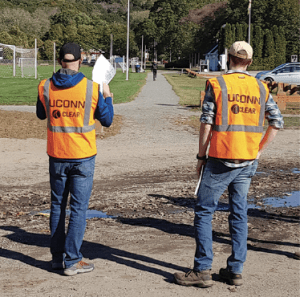
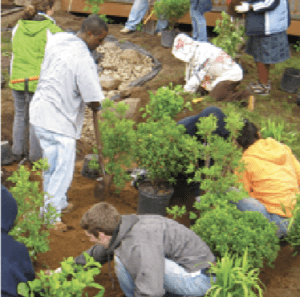
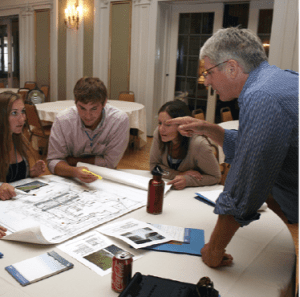
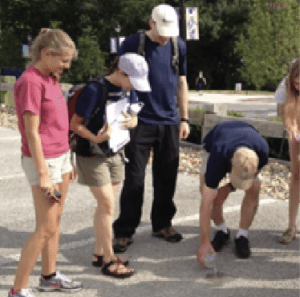
Fall 2022
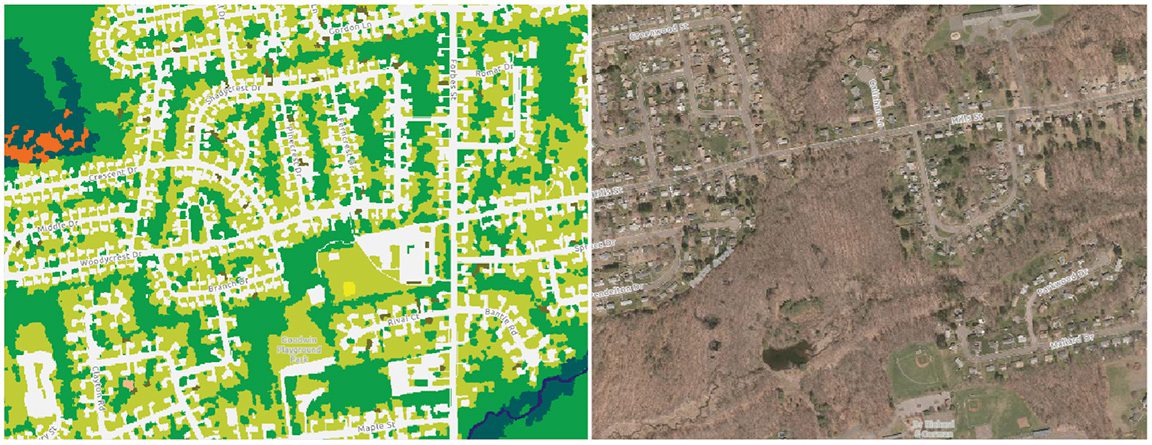
Statewide, 1-meter resolution land cover map.
A New Tool to Assess the Health of Local Watersheds in Connecticut
CLEAR has developed the Local Watershed Assessment Tool, an online tool that uses new high resolution (1 meter) land cover to estimate the health of local watersheds at a much finer scale than has ever been possible. The project was funded by the Long Island Sound Study (LISS) and was conducted in partnership with the Connecticut Department of Energy and Environmental Protection (CT DEEP) and Footprints in the Water, LLC.
Many studies throughout the country have demonstrated that there is a close relationship between watershed health and land use. However, studies of this relationship have been limited to what can be determined using moderate resolution (30 meter) land cover data. In the past, CLEAR has evaluated watersheds using its own 30m land cover data to look at critical characteristics such as impervious cover, forest cover, and riparian (streamside) land cover; these studies were done at the USGS Hydrologic Unit Code (HUC) 12-digit watershed level, which nationally averages about 36 square miles, or about 23,000 acres per watershed.
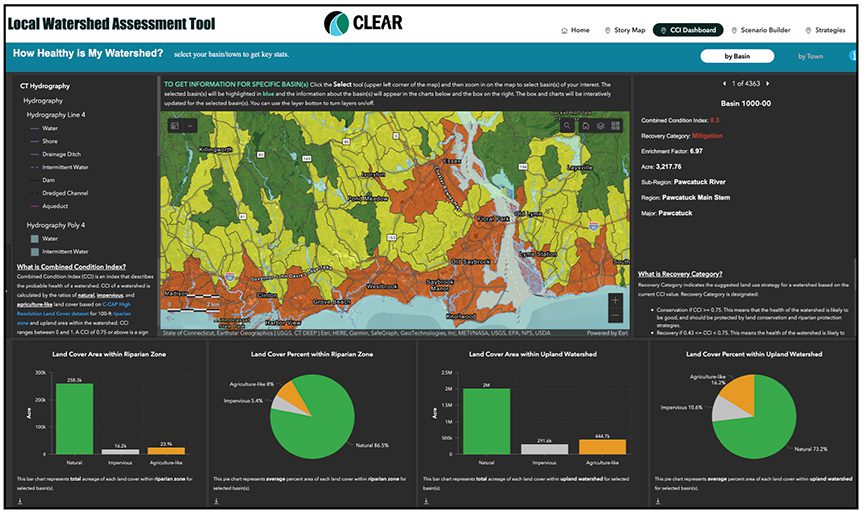
With the release of NOAA’s 1 meter land cover data for Connecticut (above image), a more targeted, localized analysis is possible. Using these data, CLEAR was able to accurately quantify land cover in much smaller watersheds. The end result is information for over 4,300 small basins across the state, averaging about 790 acres in size. The higher resolution allows for improved accuracy in determining the land cover within narrow (100-foot) riparian corridors, a critical determinant in watershed health. In addition, the 1-meter land cover has a separate impervious cover category, allowing us to directly measure impervious area rather than estimate it from models as in previous studies.
In developing the Local Watershed Assessment Tool, CLEAR used this data to analyze the land cover profiles of both the overall local basin and the 100-foot riparian zone within that basin. The combined landscape metrics were then compared with the CT DEEP network of sampling sites measuring stream bottom macroinvertebrate communities, a widely accepted method for estimating the biointegrity (health) of the drainage area upstream of the sampling site. Watershed health is then presented in the tool’s “dashboard” for each of the 4300 basins as a number called the Combined Condition Index (CCI) that ranges between 0 (worst) and 1 (best). The basins are color coded into three categories for action—Conservation, Recovery, and Mitigation—to help prioritize and guide local decisions such as riparian protection or restoration.
Nitrogen is a nutrient that is of particular concern to inland bodies of water and the Long Island Sound.
The tool dashboard also provides a nitrogen “Enrichment Factor,” or EF, for each basin. EF is an estimate of how much nitrogen is being generated by a given basin compared to the amount that would be expected from a totally forested basin. Thus, an EF of 3 would mean that the land cover profile from that basin is expected to export about three times the “pristine” (baseline) nitrogen load.
The tool also includes a “scenario builder” that allows users to see the expected changes to watershed health that result from changes to basin-wide and riparian land cover. For example, what will happen to the biointegrity (CCI) or nitrogen load if you restore more natural land in the riparian zone, and how would that effect the overall health ranking (conservation, restoration, mitigation) of that watershed? In the end, the goal is to present land cover information and its implications for watershed health at a geographic scale that will be immediately recognizable—and therefore potentially actionable—for local land use decision makers at the municipal and individual property levels.
The new Local Watershed Assessment Tool is sitting there, waiting for you to use! We encourage you to check it out. A description of the project, the data, and how to use the tool is included in the Story Map that can be reached from the home page, and there is also a video demonstration of the tool by CLEAR geospatial tool master Qian “Rachel” Lei-Parent.
Bruce Hyde Retires, Sigh!
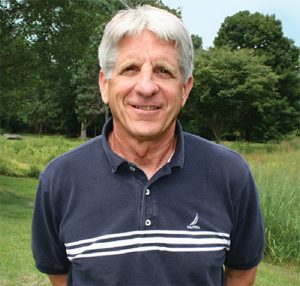 Bruce Hyde, the award-winning leader of CLEAR’s Land Use Academy and co-creator of the Climate Adaptation Academy and Climate Corps, has retired. Bruce joined CLEAR in 2010 after over 30 years in the trenches as a local land use planner. He utilized his wealth of local planning experience in Connecticut and Vermont to help train countless numbers of local land use commissioners and others throughout the state. Proving the old dog/new tricks axiom wrong, Bruce pioneered the use of “clickers” at CLEAR as one of his many tools for engaging his audiences.
Bruce Hyde, the award-winning leader of CLEAR’s Land Use Academy and co-creator of the Climate Adaptation Academy and Climate Corps, has retired. Bruce joined CLEAR in 2010 after over 30 years in the trenches as a local land use planner. He utilized his wealth of local planning experience in Connecticut and Vermont to help train countless numbers of local land use commissioners and others throughout the state. Proving the old dog/new tricks axiom wrong, Bruce pioneered the use of “clickers” at CLEAR as one of his many tools for engaging his audiences.
Recognizing the need for municipalities to begin to discuss, prepare for, and adapt to the impacts of a changing climate, Bruce and Dr. Juliana Barrett (CLEAR and Connecticut Sea Grant) created the Climate Adaptation Academy. The Academy created a forum and tools for grappling with complex issues such as retreat, living shoreline protection, road flooding, and legal issues related to climate change. Bruce and Juliana also created the multiple award-winning UConn Climate Corps to train undergraduate students about local climate adaptation and enlist them to help with practical and significant local adaptation projects.
Through it all, Bruce has maintained a laser focus on the needs and challenges of local land use decision makers by providing practical tools and materials to help them make reasoned and sustainable decisions for their communities.
His efforts have been recognized with awards from the Connecticut Chapter of the American Planning Association, the UConn College of Agriculture, Health and Natural Resources, and the UConn Provost’s office. CLEAR staff will miss his wealth of knowledge and insight, no-nonsense approach, and engaging personality, not to mention his ability to keep us focused with a well-placed sigh.

Dr. Zbigniew Grabowski
CLEAR is happy to announce the addition of a new Water Quality Educator to the team, Dr. Zbigniew Grabowski, also known as “Zbig.” Zbig is a UConn Alum with a Ph.D. in Earth, Environment, and Society from Portland State University. He brings experience as a sustainability researcher, program manager, and catalyst at the Cary Institute of Ecosystem Studies and The New School in New York. His focus at CLEAR will be working with communities on green infrastructure, land conservation, and riparian restoration with an emphasis on equity and justice.

Mary Looney
Slightly less new, but equally exciting, Mary Looney has taken over for Amanda Ryan as CLEAR’s Municipal Stormwater Educator. Mary brings her experience from working on DEEP’s regulatory stormwater programs to help communities understand and comply with the MS4 statewide stormwater permit. She is also helping communities interested in exploring stormwater utilities and working with the UConn Stormwater Corps to identify opportunities for implementing green stormwater infrastructure (GSI).
Stormwater Utilities Project
As part of the Governor’s climate bill in 2021, all Connecticut municipalities were authorized to establish stormwater utilities to cover the rapidly increasing costs of stormwater management brought on by new federal regulatory requirements and climate change. A stormwater utility is a governmental entity, similar to a water or sewer utility, that charges a fee for use of the stormwater system based on the amount of impervious cover one has on their property. Because fees are based on the amount of stormwater a property owner is contributing to the system, it is often considered a more equitable, as well as stable, source of funding for maintenance and upgrades. Stormwater utilities are a common approach to both alleviate or prevent flooding and address the problem of polluted runoff in most of the country, but they have only recently started to gain traction in the Northeast.
In collaboration with Connecticut Sea Grant, CLEAR has launched an outreach effort aimed at helping Connecticut communities decide if a stormwater utility makes sense for them. CLEAR has launched a webinar series focused on different aspects of setting up and running a utility, set-up a website with case studies and guidance, and is planning a soup-to-nuts stormwater utility planning workshop in the spring (2023).
To learn more visit our stormwater utilities web page.
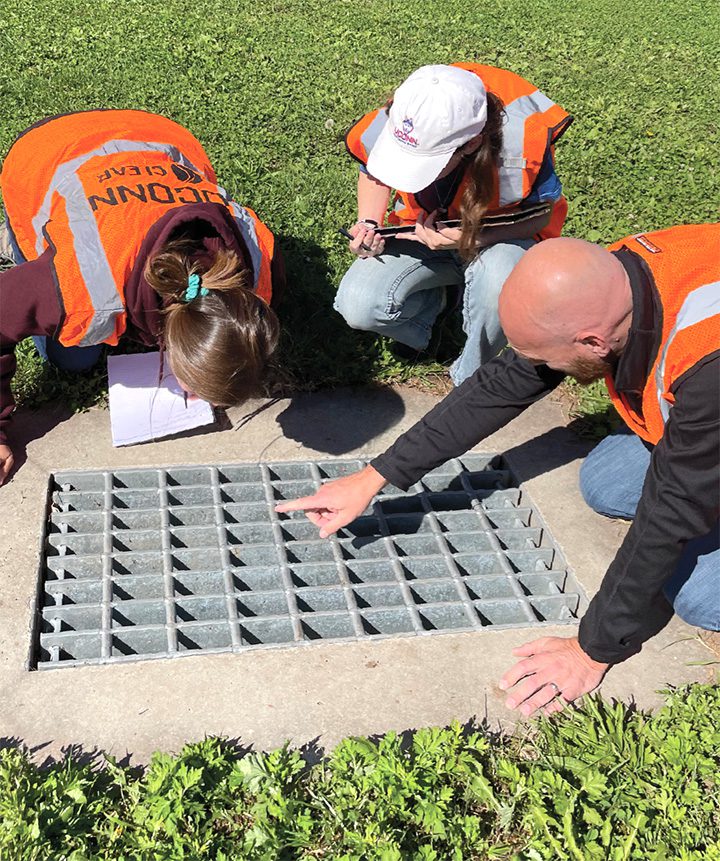
Connecticut Trail Finder
 CLEAR’s Emily Wilson has led an effort to create CT Trail Finder, a new online resource connecting people to approved trails in Connecticut, with funding support from the Connecticut Departments of Energy and Environmental Protection (DEEP) and Transportation (DOT). CT Trail Finder is a free, interactive website designed to help residents and visitors find trails with different criteria including use type (hiking, biking, snowshoeing, paddling, etc.), difficulty, accessibility, location, attraction, and more. Detailed description pages provide essential information, a map, and the ability to submit comments, photos, and a whole lot more. Users can track trail experiences, noting trails that they have completed, their favorites, or ones they want to visit. The site includes over 200 trails with more trails and features in the works. The goal is to help people get out, be active, and increase awareness of the wonderful trails across Connecticut. Have a trail to add? Learn how at CT Trail Finder or email us at trails@uconn.edu.
CLEAR’s Emily Wilson has led an effort to create CT Trail Finder, a new online resource connecting people to approved trails in Connecticut, with funding support from the Connecticut Departments of Energy and Environmental Protection (DEEP) and Transportation (DOT). CT Trail Finder is a free, interactive website designed to help residents and visitors find trails with different criteria including use type (hiking, biking, snowshoeing, paddling, etc.), difficulty, accessibility, location, attraction, and more. Detailed description pages provide essential information, a map, and the ability to submit comments, photos, and a whole lot more. Users can track trail experiences, noting trails that they have completed, their favorites, or ones they want to visit. The site includes over 200 trails with more trails and features in the works. The goal is to help people get out, be active, and increase awareness of the wonderful trails across Connecticut. Have a trail to add? Learn how at CT Trail Finder or email us at trails@uconn.edu.

Stormwater Corps Wins Regional Stormy Award
The NEMO program’s Stormwater Corps has received the 2021 Stormy Award for the Best Idea in Stormwater Management from the New England Stormwater Collaborative. The Stormwater Corps is an effort to address the capacity gap in addressing local stormwater challenges while providing UConn undergraduate students with real world experience. It consists of two courses—a classroom semester focused on the use of green stormwater infrastructure (GSI), a.k.a. low impact development, to address the impacts of stormwater runoff, and a practicum semester where students work in teams with a community to identify opportunities to implement GSI approaches. While students expand their practical knowledge and professional skills, towns receive help in complying with state stormwater mandates through recommendations about areas where they can disconnect the flow of polluted runoff from the stormwater system. This is the second time the CLEAR water team has won a Stormy Award, having received the 2017 award for our work to support municipalities in complying with Connecticut’s revamped MS4 stormwater permit. We hope to someday become the Meryl Streep of Stormy Awards.

Email: clear@uconn.edu | Phone: (860) 345-4511 | Editor: Dave Dickson | Designer: Kara Bonsack